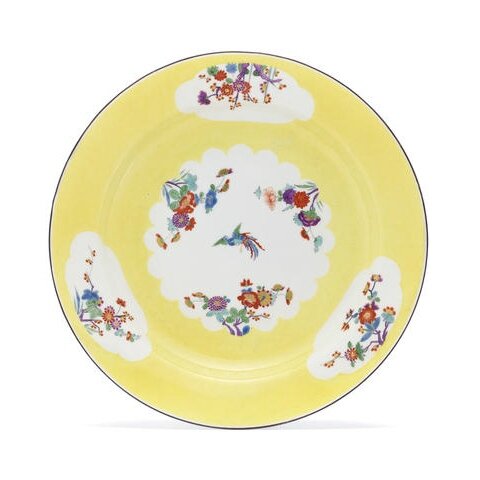A fine Meissen yellow-ground plate from the "Yellow Hunting" service, circa 1730
A fine Meissen yellow-ground plate from the "Yellow Hunting" service, circa 1730. Photo: Bonhams.
The well with a chrysanthemum-shaped reserve painted in Kakiemon style with a phoenix enclosed by three flowering bushes, the brown-edged rim reserved with three quatrefoil panels painted with similar flowering plants, 24.8cm diam., crossed swords mark in underglaze-blue, incised / inside footrim, incised Japanese Palace inventory number N-148-/ W (scattered very minor wear). Estimate £18,000 - 22,000 (€23,000 - 28,000)
Provenance: The Royal collections of Saxony, Japanese Palace, Dresden, from 1734
Literature: U. Pietsch, Frühes Meissener Porzellan aus einer Privatsammlung (1993), no. 76
Exhibited: Lübeck, Museum für Kunst und Kulturgeschichte der Hansestadt Lübeck - St. Annen-Museum, 'Frühes Meissener Porzellan aus einer Privatsammlung', 14 November 1993-31 January 1994;
Aachen, Museen der Stadt Aachen - Couven Museum, 'Frühes Meissener Porzellan aus einer Privatsammlung', 26 February-20 April 1994
This service is the only Meissen dinner-service known to have a coloured ground. It was ordered around 1730 by Augustus the Strong, and later became known as the "yellow hunting service", because of the similarity of the ground colour to the livery of the Saxon court parforce huntsmen. According to a delivery specification (published by Claus Boltz, Japanisches Palais-Inventar 1770 und Turmzimmer-Inventar 1769, in Keramos 153 (July 1996), p. 91), the service was delivered to the Japanese Palace between August and October 1734 on the instruction of Augustus III, and originally consisted of 82 pieces including 39 plates. The revised plans for the Japanese Palace specified a series of rooms, each decorated with Meissen porcelain of a particular ground colour. Unlike the celadon ground porcelain, relatively little yellow-ground porcelain was delivered before the plans for the palace stagnated from around 1738 (J. Weber, Meißener Porzellane mit Dekoren nach ostasiatischen Vorbildern, vol. II (2013), pp. 416f).
The 1770 inventory of the Japanese Palace records under 148: 'Ein Tafel Service, mit gelber(ner) Glasur und weißen Schildern, worein bunte Blumen und Vögel gemahlt...' [a table service with yellow glaze and white panels in which are painted coloured flowers and birds...]. A note in the inventory records that one plate was broken in two on 2 September 1777 at a dinner for the King of Prussia in Christinenstadt (Boltz 1996, p. 76), an indication of the importance still attached to the service (Weber, loc. cit.).
A closely similar plate as well as a tureen and fluted dish from the same service are exhibited in the Royal Collection in Dresden.(U. Pietsch/C.Banz, Triumph der blauen Schwerter (2010), p. 97). Two plates were sold in the Johanneum Duplicate Sales, Dresden 1919 and 1920, lots 192-193 and 145-146, respectively; a plate from the Deane Johnson Collection, Bel Air, was sold by Sotheby's New York, 9 December 1972, lot 67; another by Christie's Geneva, 9 May 1988, lot 63; a pair of plates was sold by Christie's London, 11 December 2007, lot 103 and another was sold by the same house in 14 July 2006, lot 84. Another plate from the service is in the Dr. Ernst Schneider Collection in Schloss Lustheim (Weber, op. cit., no. 429), and two further plates are in the Arnhold Collection, New York (M. Cassidy-Geiger, The Arnhold Collection of Meissen Porcelain 1710-50 (2008), nos. 185a-b).
Bonhams. FINE EUROPEAN CERAMICS. London, New Bond Street, 18 Jun 2014 - http://www.bonhams.com/

/https%3A%2F%2Fprofilepics.canalblog.com%2Fprofilepics%2F1%2F0%2F100183.jpg)
/https%3A%2F%2Fstorage.canalblog.com%2F03%2F02%2F119589%2F96711876_o.jpg)
/https%3A%2F%2Fstorage.canalblog.com%2F11%2F31%2F119589%2F94773502_o.jpg)
/https%3A%2F%2Fstorage.canalblog.com%2F20%2F83%2F119589%2F94772815_o.jpg)
/https%3A%2F%2Fstorage.canalblog.com%2F26%2F72%2F119589%2F75604929_o.jpg)
/https%3A%2F%2Fstorage.canalblog.com%2F59%2F60%2F119589%2F26458628_o.jpg)




/http%3A%2F%2Fstorage.canalblog.com%2F78%2F88%2F119589%2F126226333_o.jpg)
/http%3A%2F%2Fstorage.canalblog.com%2F69%2F72%2F119589%2F122404760_o.jpg)
/http%3A%2F%2Fstorage.canalblog.com%2F85%2F15%2F119589%2F122404663_o.jpg)
/http%3A%2F%2Fstorage.canalblog.com%2F55%2F26%2F119589%2F122404554_o.jpg)